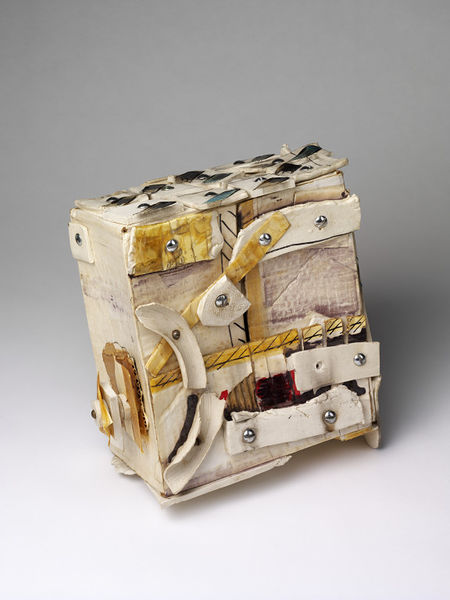Any self-respecting writer will have a library of rejected manuscripts (I remember how I cried on my first), buried inside cobweb gathering tombs of laptop hard drives, never to see the light of day and usually for a good reason.
I am not one of those self-respecting writers.
So here's an attempt at Art Review-worthy critcism from the 2011 archives. Frank feedback in the the comments box below the post would be most welcomed. The sharing icons are in grey above each post, which I still haven't figured out how to change...
I've written my fair share of embrassing, self-indulgent, juvenile rubbish, but reflection's the only way to learn right?
I've written my fair share of embrassing, self-indulgent, juvenile rubbish, but reflection's the only way to learn right?
Get in touch
Facebook Christina's Anatomy
Twitter @ChristinaLai1
Google+ Christina Lai
Postmodernism: Style and Subversion, 1970-1990
at the V&A
(24th September 2011- 8th
January 2012)
 |
| i-D, no 28. The Art Issue, August 1985, photograph by Nick Knight, featuring Lizzy Tear.V&A |
Postmodernism: Style and
Subversion is one of the VA’s most exciting projects to date. Divided into 3 sections-
Architecture, Style and Money, it examines radical ideas that defined the
movement between 1970- 1990. Its proliferation is chronicled through
stimulating exhibits- from Architecture, Art and Design to Film, Music and
Fashion. It’s ambitious to showcase a hotly contested movement, one which we
are arguably still living in. I fell slept through Postmodernism lectures at
university, so I was curious to understand what the fuss was about.
To some, it might be synonymous
with Andy Warhol soup cans and Madonna’s fashion choices- but few are aware of
its anti-modernist roots in architecture. Postmodernism is portrayed as a
phoenix rising from the ashes of modernism in the 1970s, a liberation from its
restrictive orthodoxies of function, clarity and purity. A full-scale replica
of Hans Hollein’s façade (1980) from the Venice Biennale is one of the
most theatrical exhibits. Each pillar samples a period in the history of
architecture, from the Garden of Eden, classical Greek ruins to industrialist
Art Deco. The pastiche is deliberate and unabashedly artificial (think Las
Vegas novelty hotels); playfully cutting-up-and-pasting memorable fragments
from the past.
The bricologe, cut-and-paste
ethos was not limited to styles and ideas. It brought unconventional materials
and different processes together to create a new synergy. This is evident in
Paul Astbury’s ceramic sculpture, Box(1980). At first glance it’s an
unremarkable, tatty white box hastily assembled with discarded scraps. The
broken fragments are actually fired ceramic tiles, individually fixed with
screws to the cardboard box, an unconventional mosaic tessellation. These are
accented with strokes of custom blue and brown tinted araldite, sellotape,
paint and felt tip markers. The complex layers and strategic placement of
colours makes one wonder how much of its appearance is coincidental or
deliberate. Personally, excavated remnants of demolished Modernist architecture
come to mind, eschewing progress; suggesting the present is merely an amalgam of
antiquity. It’s an intriguing, tactile synthesis of everyday materials;
refreshingly contemporary even for today.
 |
| Box, 'Untitled', Paul Astbury, 1980. V&A |
The music and performance (style)
section is not to be missed. The set (known as ‘The Club’) recreates the
electric atmosphere of an underground fetish night club from 1980s, complete
with coloured spotlights, elevated stages and wire fences. The kind your
parents would not approve of. David Bowie, Grace Jones and other 80s pop videos
repeat (annoyingly) on huge screens- charting MTV’s pivotal role of channelling
postmodernism to the mainstream audience of style conscious youths. David
Byrne of Talking Heads’ Big Suit(1983) and Grace Jones’ cubist
sculptural maternity dress (made of cardboard and felt in 1979) are just
some of the zany outfits on display. Colourful, exaggerated appearances
conveyed dissident, self-referential personas critical to these artists’
successes.
The most extreme style statements
are perhaps the male and female ballet costumes designed by Leigh Bowery for
the Michael Clark Company’s production, Because We Must(1987).
Beige balaclava-attached corset bodices are covered in exquisite crewelwork,
depicting pink, orange, gold and green sequined flowers- reinterpreting an
embroidery technique historically used for curtains. Complete with pink lycra
sequinned leggings, I imagine it would make Lady Gaga blush. The mysteriously
covered faces (with just 3 holes for sight and respiration) and sexually
provocative corset-bodies fetishize domination and submission. Epitomising fluid
postmodern gender identities, they bring a body-conscious, androgynous
‘otherness’ Bowery’s work was famous for.
 |
| Dance costumes for performance 'Because We Must', designed by Leigh Bowery, 1987. V&A |
The last section explores the
impact of money on postmodernism during the economic and consumer excesses of
the 1980s to its demise in 1990. The luxury products of ‘design editing’ are
enticing, a precursor to the current trend for artist/designer/high street
collaborations. It marks the change when designers happily merchandised their
services to mass market brands like Disney and Alessi. An iconic example is
architect Michael Graves’ Mickey Mouse Gourmet Collection(1991). A
tea-set with mouse-shaped handles and whistling Mickey spout cover reflect a
humorous, ironic self regard that defined pop culture. One can’t help but
lament a ‘selling out’ for fame and profit, relinquishing the creative freedom
postmodernists fought for in the first place. Money was power, but it also
tainted postmodernism with a ‘vulgar decadence’ that still niggles, whether we
admit or not.
For visitors unfamiliar with
postmodernism, this is a dynamic introduction to its many ‘broken facets’. The
ideas radical at the time shaped and continue to influence the world we live in
today – from parody, pluralism, bricolage to a return to kitsch and nostalgia.
There are too many objects for one to thoroughly evaluate; leaving many
questions not fully answered (Is Postmodernism dead? Does it even matter?).
However, like a time-travelling rollercoaster of unsettling, sensory thrills,
it’s more fun to do a David Byrne and ‘Stop talking sense’.
















